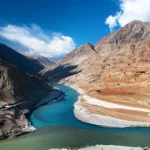
A farmer walks over the cracked soil of dried up rice field in San Ildefonso, Bulacan province. The Philippine Atmospheric Geophysical and Astronomical Services Administration warned of hotter days ahead due to El Nino. Photo by Inoue Jaena/Rappler
El Nino is an environment design that causes extraordinary climate conditions. El Nino happens when there is huge scope warming of the outside of the Pacific Ocean, which can cause dry seasons, floods and in any event, fishing and horticulture issues as its warm waters move east. El Nino goes on for somewhere in the range of nine months to two years, and it happens roughly every two to seven years. It was seen as some time in the past as the 1600s, anyway it wasn’t until the finish of the 1800s that more genuine investigation of this marvels started. It wasn’t until the 1950s that the association between El Nino and the Southern Oscillation (comparable environment changes) was made. Since 1975 both El Nino and the Southern Oscillation have been together investigated.
During the stronger El Niño episodes, the atmospheric “teleconnections” are extensive enough to cause unusually severe winter weather at the higher latitudes of North and South America.
Contrary to popular belief, global warming did not cause El Nino. It is a natural climate change that occurs as semi-regular intervals.
Strong El Niño events are associated with droughts in Indonesia, Australia, and northeastern South America and with altered patterns of tropical storms in the tropical belt.
El Nino is Spanish for Christ Child, and it was named this because El Nino usually begins to appear around the Christmas season.
The intensity of El Niño episodes varies from weak thermal anomalies (2–3 °C [about 4–5 °F]) with only moderate local effects to very strong anomalies (8–10 °C [14–18 °F]) associated with worldwide climatic perturbations.
When El Nino occurs, there is a lot of disruption of sea life, especially in coastal regions. This often has negative effects for the livelihood of many fishermen.
The timing and intensity of El Niño events vary widely. The first recorded occurrence of unusual desert rainfall was in 1525, when the Spanish conquistador Francisco Pizarro landed in northern Peru.
In 1982-83, and in 1997-98, we experienced the strongest El Nino effects in the 1900s. Australia suffered its worst drought of the century and there were very strong storm systems in the SW United States.
2016 was an El Niño year.
El Nino has been responsible for floods, droughts, thunderstorms, extreme rainfall, milder Canadian winters, lowered cyclone and hurricane activity, and dryer-than-normal monsoons.
At the start of an El Niño, the trade winds that usually whisk briskly across the surface of the tropical Pacific slacken.
During El Nino, the United States experiences wetter and cooler weather.
During El Niño years fewer hurricanes whirl across the Atlantic than usual, and the ones that do are likely to be fairly weak.
During El Nino, California experiences wetter weather.
Both El Niños and La Niñas affect weather far beyond the Pacific basin.
El Nino can be predicted with two major different systems, either the hydrodynamic coupled ocean-atmosphere model, or with statistical models.
A strong El Niño doesn’t necessarily mean the following La Niña will be particularly intense, and vice versa.
Mark Cane and Steve Zebiak were the first to successfully predict El Nino. They were using an intermediate ocean-atmosphere coupled model that they developed.
El Niños and La Niñas generally occur about every two to seven years.
El Nino occurs when the tropical Pacific waters are warmer than normal, while La Nina refers to when the tropical Pacific waters are colder than normal.
“El Niño” means “male child” in Spanish, and also refers to the baby Jesus.
Nobody is quite sure why El Nino occurs or why it occurs in a regular cycle every three to seven years or so.
El Niño can last for as long as a year, though the warming tends to be strongest during the Northern Hemisphere’s fall and winter months
Scientists have determined the effects El Nino has around the world, but not what causes it in the first place.
In 2016, corals bleached across the Pacific, floods ravaged South America, and drought-fueled fires ripped across Australia.
Cycles of disease outbreaks have been linked to the El Nino cycle. Some of these diseases that seem to be linked to events caused by El Nino include malaria, dengue, Rift Valley fever and Australian encephalitis. These are all linked to higher rainfall and flooding, as they are all transmitted by mosquitos, which thrive in wet areas.
During the 1997 to 1998 El Niño, the country sustained over $3.5 billion in damage to buildings, agricultural lands, and other infrastructure.
The food supply for sea mammals, birds and fish is disrupted by El Nino.
In the 1972 to 1973 event, ocean temperatures skyrocketed off the Peruvian coast, nearly wiping out the anchoveta fishing industry, a critical one for the country.
Both El Nino and La Nina have the ability to change the climate across more than 50% of the earth. They are the most powerful earth phenomena.
During some of the most famous El Niños of the past, the deluges have been so strong that entire villages have slid down mountainsides.
Some people believe that El Nino occurs as the result of underwater volcanoes in the Pacific Ocean, however there is no proof or definitive cause known as of yet.
During an El Niño event, the surface of the tropical Pacific Ocean gets warmer than usual, particularly at the equator and along the coasts of South and Central America.









